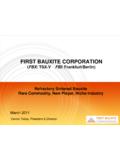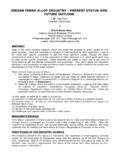Transcription of Saldanha Bay IDZ: Feasibility Study
1 Saldanha Bay IDZ: Feasibility Study Key Findings & the Process Going Forward Venue: Dial Rock Community Hall, Saldanha Bay Date: Monday, 24th October 2011. Project Sponsors: Programme IDZs as a development tool Characteristics of an IDZ. Background Study Process Governance Structures The Development Scenarios Key Findings: Economic Returns & Financial Demands Education & Training Effects Infrastructure Demands Environmental Effects Process Going Forward Requirements of an IDZ Application Closing Remarks 2. IDZs as a development tool An IDZ1 is a special type of economic zone (SEZ) generally defined as: A purpose-built industrial estate, linked to an international airport or seaport, that leverages both domestic and foreign fixed direct investments in value-added and export-oriented manufacturing industries and services, to increase competiveness and the development of linkages between domestic and zone-based industries.
2 Key Points: An IDZ is planned, designed and built around the activities to be located in it. It must be linked to an international port for the import and export of goods & services. It aims to increase competiveness & attract investment via incentives and concessions. It is a tool of regional industrial growth and development. It focuses on the export of value-added exports of goods and services. An IDZ requires domestic goods and services to support the industries located in it. Note 1: The Manufacturing Development Act (No. 187 of 1993) provides for IDZs to promote and support regional industrial growth and development as a challenge to globalisation. 3. Characteristics of an IDZ (1). A Customs Controlled Area (CCA) with dedicated SARS officials to provide support with customs and VAT requirements to those enterprises located within it.
3 A CCA offers duty rebates and VAT exemptions on imports of production- related raw materials, incl. machinery & assets, to be used in production with the aim of exporting the finished products. VAT suspension under specific conditions for supplies procured in South Africa. Efficient and expedited Customs administration. An Industries and Services Area (ISA) within the borders of the IDZ but outside of the CCA, where supportive manufacturing & services industries are located. The industries may not be importers or exporters. The ISA enterprises support the CCA enterprises and general IDZ. development, logistical services, transportation services, distribution service, training centres, etc. 4. Characteristics of an IDZ (2). An IDZ does not have to be one mass of land, pockets of land can be developed near to each other to house a CCA & ISA.
4 There can be more than one CCA and ISA which houses different industries and all can access the Port. The boundary of the IDZ does not have to be touching the Port boundary the Port can be outside of the IDZ. CCA. 3. CCA. 1 ISA. 3. ISA. 1. CCA. 2 Port ISA. 2. 5. Background 2008: Western Cape DEDT, via Wesgro initiated a Pre- Feasibility Study to identify & assess opportunities available in the industrial and business market & ascertain whether there are any binding constraints to establishing an IDZ programme at Saldanha Bay. 2009: Pre- Feasibility Study concluded & identified potential in 3 clusters: A Renewable Energy production & manufacturing cluster An Oil supply base/hub for the Oil and Gas cluster and a Maritime Ship- building and repair cluster A Steel and Minerals production & manufacturing cluster Constraints in water, energy, environment & land identified.
5 2010: Provincial & national funding sought for a comprehensive Feasibility Study . Feasibility Study must work closely & integrate with DTI , the DEADP SB EMF and SBM SDF processes & policies of the various departments involved. Multi-Disciplinary team procured & investigation started September 2010. 6. Study Process (1). Options Options Analysis Analysis Internal Review of processes &. findings within Project Team Phase 1 Studies Phase 2 Studies External Review by CHEC Peer Group Continuous Stakeholder consultation Continuous Management & Oversight by Ops Com Submission of Report to Steering Committee & public for 30 day comment period 7. Study Process (2). Phase 1 Studies Project Commercial Feasibility Assessment (Frost & Sullivan).
6 Land Assessment (Urban Dynamics Western Cape). Strategic Environmental Review (MEGA). Air Emission Modelling & Analysis (Airshed Planning Professionals). Biodiversity Analysis (Nick Helme Botanical Surveys). Technical Infrastructure Analysis (BKS). Phase 2 Studies Financial Analysis (Grant Thornton). Economic Impact Assessment (Urban-Econ Western Cape). Workforce Assessment (UWC: School of Business & Finance). 8. Governance Structures 9. The Development Scenarios (1). Three long-term scenarios developed to illustrate total potential, needs and opportunities of an IDZ in Saldanha Bay. Scenarios developed from results of a multi-criteria filtering process. 10. The Development Scenarios (2). Project Brief description of project Likelihood of Public sector support requirements Sources of funding project in short- to medium-term Marine Repair (MR) Port infrastructure development of a High -A free port 100% private sector new quay & dry-docking facilities for -Land lease arrangement with TNPA funding available.
7 The repair of O&G vessels. -IPP 12-I tax deductions applicable Offshore Supply Port infrastructure development of a High -A free port 100% private sector Base (OSB) supply quay & laydown area for supply -Land lease arrangement with TNPA funding available. of goods to offshore O&G sector. Hot Briquetted Iron 50,000tpa via a Finesmelt-type plant. Low long-term -Competitiveness of SA steel industry key factor A joint venture between (HBI) project (access to iron ore at competitive prices) private sector and public manufacturing -CCA incentives are required sector. Titanium and Zircon 15,000tpa of titanium metal + High Bankable -CCA incentives are required A joint venture between (Ti/Zr) 2,000tpa of zirconium metals + Feasibility to be -Critical Infrastructure Programme grants from private and public Complex 3,000tpaof solar grade silicon + completed end DTI sector.
8 5,000tpa high grade silicon. 2012. Wind Blade 100 sets of wind turbine blades per High -NERSA Refit incentives 100% private funding manufacturing annum. available. Renewable Energy 2,000 Solar Water Heater units per High -National Building Regs & Building Standards Act 100% private funding Industry month. -12i Tax Allowance applicable available. -Manufacturing Investment Programme from DTI 11. Pessimistic Scenario Offshore Supply Base and Marine Repair industry The indicative growth rate of this industry is Renewable Energy industry The indicative growth rate of this industry is Blade manufacturing facility Year 10, and to expand in Year 20. Titanium and Zircon Complex Year 12 & no further expansion CCA & ISA to support IDZ programme 12.
9 Base Scenario Offshore Supply Base and Marine Repair industry The indicative growth rate of this industry is Renewable Energy industry (SWH). The indicative growth rate of this industry is Blade manufacturing facility Year 7, and to expand in Year 14 and again in Year 21. Titanium and Zircon Complex Year 10 and to expand in Year 20. Hot Briquetting Iron (HBI) Plant Year 20 and no further expansion CCA & ISA to support IDZ programme 13. Optimistic Scenario Offshore Supply Base and Marine Repair industry The indicative growth rate of this industry is A Graving Dry Dock to become operational in Year 25 only Renewable Energy industry (SWH). The indicative growth rate of this industry is Blade manufacturing facility Year 4 & to expand every 4 years until Year 20.
10 Titanium and Zircon Complex: Year 6 & to expand in Year 12 & again in Year 18. Hot Briquetting Iron (HBI) Plant: Year 10 and no further expansion CCA & ISA to support IDZ programme 14. Key Findings (1). Economic Returns Increase in GGP relative to current SBM GGP (ave. pa over 25 years) =. 86%-233%. Imported Capital Goods = 54%-57%. Government : Private Funding ratio (Capex) = 1:4. % Foreign of Private Sector (Capex) = 54%-31%. Recovery due to Taxation (Capex) = 33%-29%. 15. Key Findings (2). Economic Returns Sustainable Direct Jobs* Created = 4,240-8,930. Sustainable Total Jobs* Created = 11,975-29,020. Cost to Government, per Job* Created = million Total** jobs* created (ave. pa over 25 years) = 10,000-25,910. Increase in jobs relative to current SBM employment = 16%-34%.






